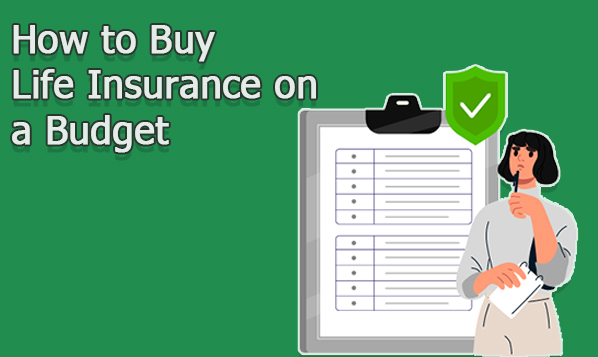How to Buy Life Insurance on a Budget – Life insurance is often purchased as a safety net to help surviving family members recover from a significant loss without facing financial hardship. Depending on the insurer’s preferences, a premium may be paid in full, every month, annually, or quarterly basis. Gender, age, policy term, lifestyle, occupation, and preferred coverage all affect the premium.

To buy a life insurance plan that fits your budget, understand factors affecting premium costs like sum assured, policy duration, riders added, and policy type. Additionally, carefully selecting the sum assured is essential because a smaller sum might not be very useful. Finding the right life insurance plan within your price range can be made easier in this article.
How to Buy Life Insurance on a Budget
Life insurance can be affordable, especially when purchased during a young and healthy age. There are a few strategies to buy a life insurance rate if you’re on a tight budget. The following steps include;
Know the coverage type you need
The most basic and affordable kind of policy is term life insurance, which covers a predetermined number of years for financial obligations or dependents. Your beneficiaries get paid if you pass away within the term. Because of its full life coverage and potential for cash value growth, permanent life insurance is more costly than whole life insurance. Variable and universal life insurance offers payment flexibility, allowing premium adjustments based on income fluctuations. For people who require a permanent policy, these policies are appropriate.
Choose the coverage amount needed
Your coverage amount needed should be considered when purchasing life insurance. The beneficiary’s claim amount is the amount they could receive if they file a claim within the policy term. Once you have your sum assured, you can adjust other policy components to ensure you have appropriate life insurance.
Choose to take a medical exam
For healthy people, a life insurance medical examination is advised. A doctor records the patient’s height, weight, blood pressure, medical history, and nicotine, cholesterol, and glucose levels during this examination, which is comparable to a physical. This data is used by the insurer to determine rates. Without a medical examination, life insurance is riskier and more costly. You can make an appointment at home that works for you. Premiums are then determined by the insurer using this data.
Set financial goals for your coverage
The main goal of purchasing life insurance is to leave money for the people or things that are significant to you. The money you pay the insurance company in premiums goes toward the death benefit, which is the amount you get paid after you pass away. People often save this money to support a cause, make last-minute arrangements, or cover the living expenses of their family. A life insurance policy can be utilized to save money, boost retirement income, or provide a source of income for surviving family members post-death.
Determine if you need life insurance riders
Riders are additional benefits or options that can be added to life insurance policies to create customized coverage. Common types include Children’s Term Rider, Accelerated Death Benefit Rider, Accidental Death Benefit Rider, and Waiver of Premium Rider. Children’s Term Rider allows parents to cover their children under the policy, with the insurer paying out a death benefit if the child dies before the specified age. Accelerated Death Benefit Rider allows access to death benefits before death if diagnosed with a terminal illness or disease. Accidental Death Benefit Rider increases death benefit if injured in an accident.
Buy coverage early
The age of the insured can affect the cost of life insurance premiums; younger people typically find less expensive plans. This is because older people are more likely to die. The best time to buy life insurance on a budget is when you’re younger. This is because premiums may go up as you get older. Selecting a plan that meets your needs and doesn’t cause current stress can help you find a suitable budget option.
Request for discount
Most insurance companies offer options for monthly, quarterly, semiannual, or annual premium payments. However, some insurers impose fractional premiums, or an extra service charge, on policyholders who decide for regular payments. Paying your premium once or twice a year could save you up to 5% if you can afford the larger upfront payment.
Shop around
When you intend to buy life insurance on a budget, there are numerous ways to do so, and not all of them involve paying a lower premium immediately. However, quotes from different providers can differ greatly because life insurance is a highly competitive industry. Also, consider how crucial it is that you obtain the coverage that best suits your financial objectives and budget. When dealing with an agent directly, ensure they understand your financial situation and provide a clear explanation of your options.
Finally, the last step is to just start your life insurance application after you’ve done your research. Once you receive the actual rate, you can evaluate if it aligns with your financial constraints. Otherwise, continue shopping. Furthermore, purchase a term life insurance for peace of mind, available at no cost to you and your loved ones.

